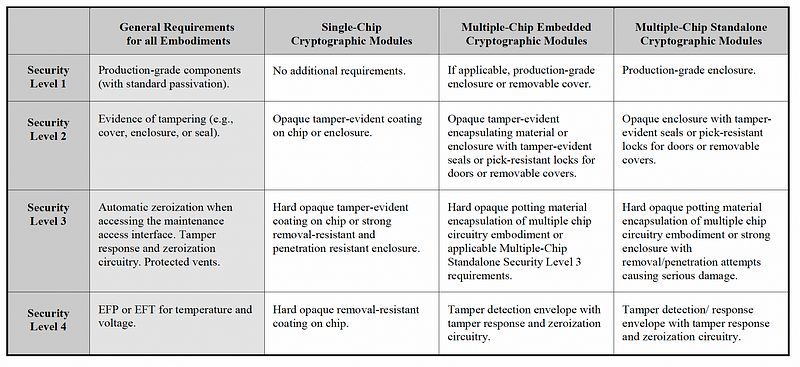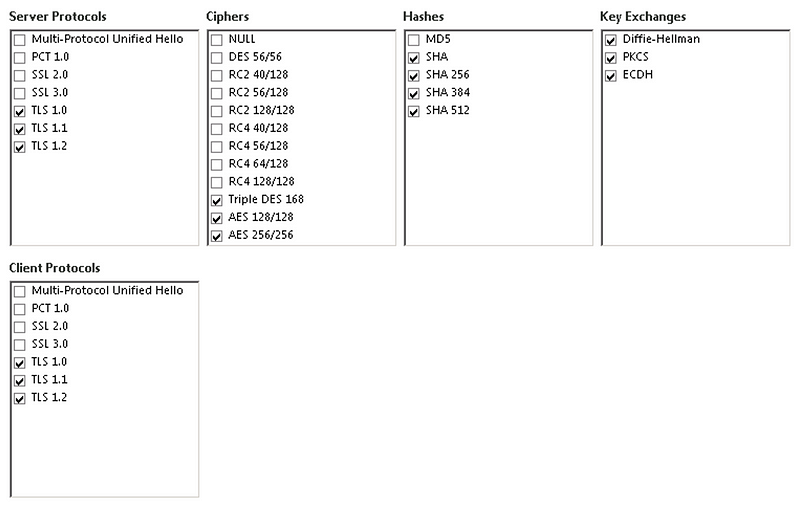How Do You Measure How Good Your Company’s Security Is? Well, FIPS-140 Is One Measure

How Do You Measure How Good Your Company’s Security Is? Well, FIPS-140 Is One Measure
The US government defines a number of standards that many companies comply with, and one of the strongest is FIPS (Federal Information Processing Standard) 140. This standard defines a number of levels that define the security level of a product/system and includes modules tested within the Cryptography Module Validation Program (CMVP).
In 2019, FIPS 140–3 replaced FIPS 140–2. It defines 11 areas of design involved in designing and implementing modules [here][docs]. This includes four security levels for the cryptographic module specification; cryptographic module interfaces; roles, services, and authentication; software/firmware security; operating environment; physical security; non-invasive security; sensitive security parameter management; self-tests; life-cycle assurance; and mitigation of other attacks. Each layer builds on the previous level, and where Level 1 is the lowest level, and Level 4 provides the highest level. For those working in finance and in high-risk areas, Level 3 is often the benchmark, while in defence-related areas, Level 4 would often be applied. Table 1 outlines the differences between the levels.

For physical security, the tamper-proof nature of the target system is key, and where tamper detection becomes important at the higher levels of security.

As Figure 1 illustrates, Level 1 provides a minimum security level, while Level 2 implements methods around role-based authentication, and also integrate physical tamper-evidence. As we move up to Level 3, we integrate identity-based authentication and also has an isolation barrier between the identity system and the place that the keys are stored. This would integrate a secure enclave (such as with the Apple T2 chip), or a hardware security module (HSM). For Level 4, we see formal models, detailed explanations, and pre/post conditions. It also contains a great integration of tamper detection, with EFP (Environmental Failure Protection) and EFT (Environmental Failure Testing). This would involve testing where other components around the target system were to fail, and for the target to not be compromised. A typical focus is around side channels, such as for radio frequency (RF) or electromagnetic (EM) radiation from devices.

For isolation, a method often used is key wrapping, and where a key is protected outside a trusted environment. Within the Cloud, AWS CloudHSM (hardware security module) supports AES key wrapping with the default initialization vector — 0xA6A6A6A6A6A6A6A6- or a user-defined value. This provides a FIPS 140–2 Level 3 environment and where the keys in their raw form are only handled within a trusted cloud instance. The wrapped keys can then exist outside this but only converted into their actual form within the CloudHSM. A key generated within the CloudHSM can then be wrapped for export from the environment, or imported from an external wrapped key. The AWS CLI is on the form which defines a key handle (with -k) and the wrapping key handle (with -w):
> wrapKey -k 7 -w 14 -out mykey.key -m 5
Key Wrapped.
Wrapped Key written to file "mykey.key: length 612
Cfm2WrapKey returned: 0x00 : HSM Return: SUCCESS
Within FIP140–3, the approved methods are:
- Symmetric key: AES-128, AES-192 and AES-256. Acceptable modes are ECB, CBC, CBC with ciphertext stealing, OFB, CTR, CCM, GCM, XTS, and AES Keywrap. AES is the only approved method, but Triple DES can be used in existing applications (but requires a key length of at least 192 bits).
- Digital Signatures: This requires a security level of 112 bits or more. For RSA signatures, we require the keys to be 2,048 bits or more. For DSA: (2048-bit keys, 224-bit hash); (2048-bit keys, 256-bit hash) and (3072-bit keys, 256-bit hash). For ECDSA and EdDSA we require a key size of 224 bits or more, such as the NIST P-256 curve. Approved curves include NIST P-224, P-256, P-384 and P-521 curves.
- Hashing: For hashing, the SHA-1 is not recommended, as it has been broken. The approved ones are SHA-2 (SHA-224, SHA-256, SHA-384, SHA-512, SHA512/224, and SHA-512/256), and SHA-3 (SHA3–224, SHA3–256, SHA3–384, SHA3–512, SHAKE128, and SHAKE256).
- MAC (Message Authentication Code): HMAC methods must have 112 bits or more, and for the approved AES and hashing ciphers.
- Key exchange. For Diffie-Hellman (DH) we require at least a 2,048-bit prime number, and some of the acceptable methods are MODP-2048, MODP-3072, MODP-4096, MODP-6144, and MODP-8192.
To be FIPS140–2 compliant, a Web server setup can be set up with a mixture of these:

You can view more on trusted hosts here: